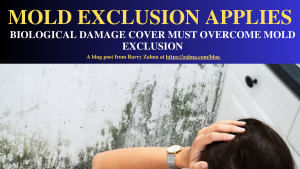MOLD EXCLUSION APPLIES

See the full video at https://rumble.com/v2kdv58-mold-exclusion-applies.html and at https://youtu.be/QDGZm97rUPA
In Clay Buchholz; Lindsay Buchholz v. Crestbrook Insurance Company, doing business as Nationwide Private Client, No. 22-50265, United States Court of Appeals, Fifth Circuit (April 18, 2023) Clay and Lindsay Buchholz sued their insurer after recovering $745,778 for damage to their ten-thousand-square-foot house in Austin, Texas.
The Buchhholz’ insured their home with Crestbrook Insurance Company. Their policy included “Biological Deterioration or Damage Clean Up and Removal” coverage (“mold coverage”). The Buchholz family discovered a widespread mold infestation in their home. Although Crestbrook covered many of their losses, it denied a generalized claim for mold growing in the Buchholzes’ walls and heating, ventilation, and air conditioning system. A magistrate judge issued a report and recommendation in favor of Crestbrook, and the district court adopted the magistrate judge’s conclusions.
FACTS
Crestbrook paid $745,778 in covered losses on five of the six claims submitted. However, Crestbrook asserted that the sixth claim for general mold growth and mold in the HVAC system was excluded. The Buchholz family retained MLAW Forensics, Inc., to investigate the cause of their mold infestation. Crestbrook paid for MLAW’s investigation. Dean R. Read, P.E., wrote a causation report on what he concluded led to the mold growth at the Buchholzes’ house that found that “discrete leaks and a ‘global’ issue due to interruption or restriction of the moisture vapor drive drying process” caused the mold. Specifically, he concluded that the house’s HVAC system was “[i]mproperly designed or configured and non-functional,” which resulted in “elevated moisture content []” and subsequent mold growth.
Based on MLAW’s causation report Crestbrook denied Appellants’ mold claim. The denial letter referred to policy exclusions for biological deterioration or damage, a defect or inadequacy in design, workmanship, construction and materials. In addition, the policy contained exclusions for weather conditions or dampness, and gradual or sudden loss due to a mechanical breakdown. Crestbrook concluded that the biological deterioration or damage additional limited coverage would not apply to this claim.
In their final complaint, the Buchholz family alleged that Crestbrook breached their insurance contract in bad faith and violated the Texas Insurance Code. The magistrate judge concluded that the Buchholz family had failed to demonstrate a “covered cause of loss” as required by their mold coverage.
ANALYSIS
Under Texas law, when deciding a dispute regarding insurance coverage, the court first looks to the language of the policy because it presumes parties intend what the words of their contract say. The court must give the policy’s words their ordinary and generally accepted meaning unless the policy shows the words were meant in a technical or different sense. A disagreement between the parties regarding the meaning of policy terms or interaction between terms does not create ambiguity.
The Insured’s Burden
In a coverage dispute, the insured has the burden first to prove that their loss falls within the terms of the contract. Once the insured demonstrates this, the burden shifts to the insurer, who, to avoid liability, must show that the loss falls into an exclusion to the policy’s coverage.
The Fifth Circuit Conclusion
The Fifth Circuit concluded that the magistrate judge correctly laid out the Texas insurance dispute burden-shifting framework in her report and recommendation she concluded: “[The Buchholzes] fail to identify the cause of the mold damage. Instead, [the Buchholzes] submit that the Policy is an inclusive, all risk policy that covers all-risk of accidental direct physical loss to the property unless an exception applies… Accordingly, [the Buchholzes] fail to meet their burden to show that the Mold Claim is covered under the [mold coverage] provision.”
In its motion for summary judgment, Crestbrook argued that mold infestation is an excluded peril under the policy. Applying the Texas insurance burden-shifting framework, the Fifth Circuit agreed with Crestbrook that the mold exclusion bars coverage for the Buchholz family’s claim. Under the Texas insurance dispute framework, the Buchholzes must first show a direct physical loss as required under their all-risk policy. Then Crestbrook can identify any exclusions to coverage of that loss.
The policy excluded coverage for “loss to any property resulting directly or indirectly from any of the following . . . Biological Deterioration or Damage, except as provided by [the mold coverage].”
The Buchholzes showed they suffered a mold infestation, nothing more.
Their theory is that water intrusion causes mold. But water intrusion as such is not a loss covered by the policy when its only manifested harm to covered property is fungal growth. Consequently, the Buchholzes did not show that their mold coverage serves as an exception to the mold exclusion. So, their generalized mold claim is excluded by the terms of their policy.
Although the Fifth Circuit found that the district court incorrectly applied the Texas insurance coverage burden-shifting framework Crestbrook is still entitled to summary judgment because it has demonstrated that a generalized mold claim is excluded under the policy.
The Fifth Circuit concluded that it was required to interpret the insurance policy as it was written and that the generalized mold claim was clearly and unambiguously excluded. Nothing more need be said. The Buchholzes should not have sued their insurer they should have sued the contractor, designer or manufacturer of the defective HVAC system. In fact they should join with their insurer in seeking damages from those who were responsible for the defects that caused the mold infestation.
 (c) 2023 Barry Zalma & ClaimSchool, Inc.
(c) 2023 Barry Zalma & ClaimSchool, Inc.
Subscribe and receive videos limited to subscribers of Excellence in Claims Handling at locals.com https://zalmaoninsurance.locals.com/subscribe.
Consider subscribing to my publications at substack at https://barryzalma.substack.com/publish/post/107007808
Barry Zalma, Esq., CFE, now limits his practice to service as an insurance consultant specializing in insurance coverage, insurance claims handling, insurance bad faith and insurance fraud almost equally for insurers and policyholders. He practiced law in California for more than 44 years as an insurance coverage and claims handling lawyer and more than 54 years in the insurance business. He is available at http://www.zalma.com and zalma@zalma.com
Follow me on LinkedIn: www.linkedin.com/comm/mynetwork/discovery-see-all?usecase=PEOPLE_FOLLOWS&followMember=barry-zalma-esq-cfe-a6b5257
Write to Mr. Zalma at zalma@zalma.com; http://www.zalma.com; http://zalma.com/blog; daily articles are published at https://zalma.substack.com. Go to the podcast Zalma On Insurance at https://anchor.fm/barry-zalma; Follow Mr. Zalma on Twitter at https://twitter.com/bzalma; Go to Barry Zalma videos at Rumble.com at https://rumble.com/c/c-262921; Go to Barry Zalma on YouTube- https://www.youtube.com/channel/UCysiZklEtxZsSF9DfC0Expg; https://creators.newsbreak.com/home/content/post; Go to the Insurance Claims Library – https://zalma.com/blog/insurance-claims-library.
Like this:
Loading…
Related







